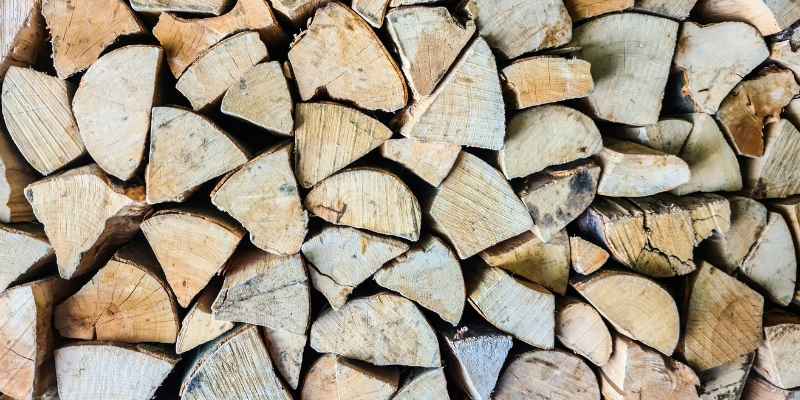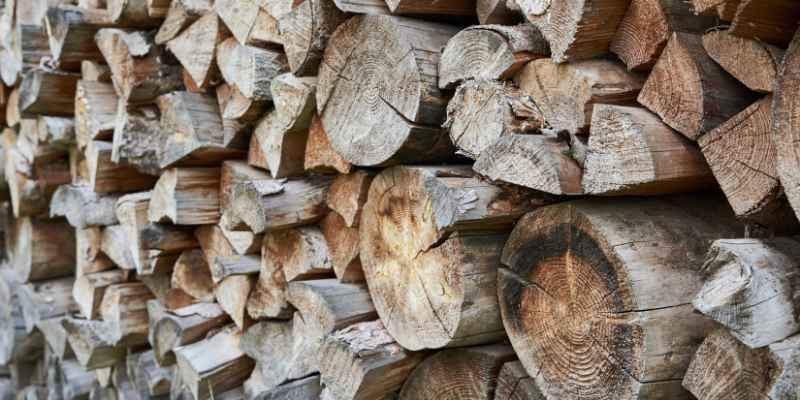For the winter, you will typically need around 2 to 3 ricks of wood. This quantity may vary depending on the size and insulation of your space.
A cord of wood can last as long as ten weeks, so having one to two cords should be sufficient to get you through the winter season.
Importance Of Properly Estimating Wood Needs
Estimating the right amount of firewood for winter is crucial in ensuring you stay warm throughout the season.
Determining The Amount Of Firewood Needed
To accurately determine your wood needs, consider factors like the size of your space and the efficiency of your heating system.
Considerations For Estimating Wood Needs
- Calculate the total square footage you need to heat
- Factor in the type of wood you are using
- Consider the average winter temperatures in your area
| Number of Ricks | Approximate Firewood Equivalent |
|---|---|
| 1 Rick | 1/3 to 1/2 cord |
| 2 Ricks | 2/3 to 1 cord |
| 3 Ricks | 1 to 1.5 cords |
Properly estimating your wood needs can help you avoid running out of firewood during the coldest months of winter.
Factors Influencing Wood Consumption
To determine how many ricks of wood are needed for the winter, factors such as the size of the space to heat and its insulation play a role. Typically, one to two cords of wood can last throughout the winter season, but this may vary depending on individual circumstances.
When planning for winter, one crucial aspect to consider is how much firewood you will need to keep your living space warm and cozy. The amount of wood required can vary based on various factors. Let’s take a look at the key factors that influence wood consumption:
Size Of Space To Be Heated
The size of the space you need to heat is a significant factor in determining your firewood consumption. Larger spaces will require more wood to maintain a comfortable temperature throughout the winter. If you have a spacious living area with multiple rooms, you can anticipate needing a larger quantity of firewood.
Insulation Level Of The Space
The insulation level of your space plays a crucial role in how efficiently heat is retained. Well-insulated spaces will require less firewood as the heat will stay trapped indoors for longer periods. On the other hand, if your home has poor insulation, you will likely lose heat faster, necessitating the burning of more firewood to compensate for the heat loss.
Climate Conditions
The climate in your region is another vital factor to consider when estimating your firewood needs. Colder climates with harsh winters will require more firewood to combat the lower outdoor temperatures. Areas with milder winters may require fewer firewood supplies. It’s essential to research the typical winter temperatures in your specific location to get a more accurate estimate.
Usage Of Wood Stove Or Fireplace
The type of heating appliance you use also impacts your firewood consumption. Wood stoves and fireplaces consume firewood at different rates due to variations in their design and efficiency. Wood stoves tend to burn wood more efficiently and produce higher heat output. Fireplaces, on the other hand, may result in some heat loss through the chimney. This difference can affect the amount of firewood you need to stock up on for the winter.
Considering these factors, it’s essential to make an informed estimate of the amount of firewood you will need for the winter season. By taking into account the size of your space, the level of insulation, the climate conditions, and the type of heating appliance you have, you can ensure that you have a sufficient supply of firewood to keep you warm and comfortable throughout the winter.
Understanding Different Wood Measurement Units
To prepare for winter, it’s crucial to understand the amount of firewood needed, typically ranging from one to two cords for the season. Variables like space size and insulation level impact wood consumption, with some households requiring up to ten cords.

Plan ahead to ensure ample supply.
Cord Of Wood
? A cord of wood is a standardized unit of measurement that typically equates to a stack of wood 4 feet high, 4 feet wide, and 8 feet long.
? It’s important to know that not all wood measurements are the same. Cord of wood – 4x4x8ft stack.
Rick Of Wood
? A rick of wood is a less standardized unit of measurement, often measured as a stack of wood 4 feet high, 8 feet long, and the width can vary. Rick of wood- 4x8ft stack.
Firewood Bundles
? These are smaller, pre-packaged bundles of firewood and are usually sold by the bundle or by weight.
Understanding the different wood measurement units is essential when buying firewood for the winter. It helps you accurately estimate the amount of wood you need and manage your supply efficiently.
Guidelines For Calculating Required Wood Quantity
When preparing for the winter season, ensuring you have an adequate supply of firewood is crucial. Calculating the required wood quantity accurately can save you from the inconvenience of running out of wood during the cold months. To help you with this, we’ve compiled some guidelines on how to calculate the amount of wood needed for winter.
Average Consumption Rates
It’s essential to consider the average consumption rates when determining the required amount of firewood. On average, a household will use approximately 3-5 ricks of wood during the winter season.
Duration Of The Winter Season
Considering the duration of the winter season is crucial for estimating the required wood quantity. In regions with longer and harsher winters, the consumption of firewood may be higher compared to milder climates.
Specific Tips For Accurate Estimates
- Assess the insulation and size of your living space to gauge the amount of firewood needed.
- Factor in any additional heating sources that may reduce the reliance on firewood.
- Consult with experienced firewood suppliers or professionals for personalized advice.
Practical Strategies For Sourcing Firewood
When it comes to preparing for the winter season, ensuring a reliable and sufficient supply of firewood is essential. Whether you choose to collect the wood yourself, buy from local suppliers, or opt for the convenience of online delivery services, having a practical strategy in place will help you stay warm throughout the colder months.
DIY Wood Collection
If you enjoy being outdoors and want to save money, collecting firewood yourself can be a rewarding and cost-effective option. Here are some tips for DIY wood collection:
- Identify nearby sources of wood, such as parks, forests, or private properties where you have permission to collect fallen or dead trees.
- Ensure you have the appropriate tools for cutting and splitting the wood, such as a chainsaw, axe, and splitting maul.
- Always prioritize safety by wearing protective gear, including gloves and safety goggles, and using caution when operating equipment.
- Consider the type of wood you want to collect, as different types have varying burn times and heat output.
- Allow sufficient time for the wood to dry, as green or wet wood can be challenging to burn and less efficient.
- Stack and store the wood properly in a dry and well-ventilated area to prevent moisture accumulation and potential mold or insect infestation.
Local Firewood Suppliers
If the process of collecting and preparing firewood seems overwhelming or time-consuming, local firewood suppliers can provide a convenient solution. Here are some advantages of sourcing firewood from local suppliers:
- Access to seasoned firewood that is ready to burn, eliminating the need for drying and storage.
- Professional expertise in selecting and providing high-quality wood suitable for efficient and clean burning.
- Assurance of sustainable and environmentally responsible sourcing practices.
- Supporting local businesses and the community.
- Convenience of delivery or pickup options, allowing you to choose the most convenient method for your needs.
Online Firewood Delivery Services
With the increasing popularity of online shopping, it’s no surprise that firewood delivery services have also become readily available. Here are some benefits of opting for online firewood delivery:
- Wide range of options, including different wood types, quantities, and packaging.
- Ability to compare prices and read reviews from other customers.
- Convenience of doorstep delivery, saving you time and effort.
- Flexible scheduling options that cater to your specific requirements.
- Access to customer support for any inquiries or concerns you may have.
Efficient Wood Storage And Seasoning
Storing wood properly is crucial for efficient burning in winter. Keep wood off the ground to prevent moisture absorption.
Stack wood in a well-ventilated area that allows air circulation to aid in the seasoning process.
Seasoning wood ensures it burns efficiently, producing more heat and less smoke. Properly seasoned wood reduces creosote buildup in chimneys.
Allow wood to season for at least 6-12 months to reach optimal moisture content for burning.
- Avoid stacking wood next to a building to prevent pest infestations and ensure proper airflow.
- Do not cover wood completely as it hinders airflow and slows down the seasoning process.
- Regularly inspect wood for signs of decay and remove any rotten pieces to maintain quality.
Making The Most Of Your Firewood Supply
During winter, having enough firewood to stay warm is crucial. It’s vital to determine how many ricks of wood you’ll need to last through the season effectively.
Optimizing Wood Burning Efficiency
- Choose seasoned wood for better heat output.
- Keep your woodpile covered to protect it from moisture.
- Regularly clean out ash from the fireplace or stove for optimal airflow.
Implementing Energy-saving Practices
- Use airtight stoves to maximize heat retention.
- Seal any gaps or leaks in your home to prevent heat loss.
- Utilize a programmable thermostat to regulate indoor temperatures efficiently.
Using Alternative Heating Methods
- Consider pellet stoves or wood boilers for eco-friendly heating.
- Install ceiling fans to circulate warm air more effectively.
- Explore solar heating options to reduce reliance on traditional wood burning.
By optimizing your wood burning efficiency, implementing energy-saving practices, and using alternative heating methods, you can make the most of your firewood supply for a warm and comfortable winter season.
Evaluating Wood Consumption Metrics

Comparison Of Different Wood Quantities
When preparing for winter, one of the essential tasks for homeowners who rely on wood-burning for heating is to determine the amount of wood required. Common units used for measuring wood include cords, ricks, and face cords. Understanding the difference in these quantities is crucial for evaluating wood consumption metrics.
Feedback From Experienced Wood Burners
Experienced wood burners can provide valuable insights into the amount of wood required for winter. Their feedback can offer practical tips and considerations, such as climate variations, wood types, and insulation quality, to help homeowners make informed decisions about wood consumption.
Calculating Your Actual Wood Usage
It’s important for homeowners to calculate their actual wood usage based on the size of their living space, frequency of wood burning, and the efficiency of their wood-burning appliance. By knowing their actual wood usage, homeowners can avoid overstocking or running out of wood during the winter season.
Frequently Asked Questions On How Many Ricks Of Wood For Winter
How Much Wood Do You Need To Burn In The Winter?
To stay warm all winter, you’ll likely need multiple cords of firewood, potentially 10 or more depending on your heating needs and insulation.
How Many Logs Do You Need For Winter?
You’ll need multiple cords of firewood for a whole winter; around ten cords or more, depending on your heating needs and insulation.
How Long Will A Rick Of Wood Last?
A rick of wood can last as long as ten weeks, but it depends on variables such as space size and insulation. Generally, one to two cords of wood may last through the winter.
Will A Cord Of Wood Last All Winter?
Yes, a cord of wood will last all winter, typically for about 10 weeks. The exact duration may vary based on space size and insulation. You may need one to two cords for the winter.
Conclusion
To determine how many ricks of wood you need for winter, it’s important to consider various factors such as the size of the space you need to heat and its insulation. Generally, one to two cords of wood should be enough to last you through the winter.
Keep in mind that the amount of firewood you need may vary based on your specific circumstances. Ultimately, having multiple cords of firewood on hand will ensure you stay warm and cozy all winter long.


